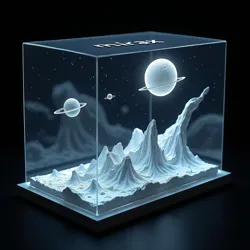Xenosemantic Drift
 A holographic model showing the transformation of the Centaurian word "mhirax" as it evolved from describing stellar phenomena to human emotional states
A holographic model showing the transformation of the Centaurian word "mhirax" as it evolved from describing stellar phenomena to human emotional statesXenosemantic Drift refers to the systematic process by which extraterrestrial loanwords undergo semantic change after being adopted into human languages, particularly English, following First Contact in 2031. This linguistic phenomenon, first identified by Dr. Elena Volkov at the Institute of Xenolinguistic Studies in 2034, describes how alien terms often develop new meanings and connotations as they integrate into human cultural contexts.
Theoretical Framework
The foundational theory of Xenosemantic Drift emerged from the observation that extraterrestrial concepts rarely map perfectly onto human experiential frameworks. The High Centaurian term "shaarax," which initially described their specific method of faster-than-light travel, demonstrates this evolution clearly. While it retained its technical meaning in scientific contexts, it underwent semantic broadening to encompass various forms of rapid transportation in everyday usage.
The Proximan Trade Language has provided numerous examples of semantic drift, particularly in terms related to consciousness and perception. The Proximan word "melphai," originally denoting a specific meditative state achieved during interstellar navigation, has evolved in human usage to describe any state of heightened awareness or focus, regardless of its connection to space travel.
Mechanisms of Change
Xenosemantic drift typically occurs through several identified mechanisms. The primary process, termed Conceptual Realignment, involves the gradual shift of an alien concept to fit within human cognitive frameworks. This process is particularly evident in terms borrowed from Deep Andromedic, where complex multidimensional concepts are often simplified and recontextualized for human understanding.
Secondary drift occurs through what linguists call "cultural contextualization," where alien terms acquire additional meanings based on their use in human social contexts. The Rigellian term "zht'khor," originally describing a specific form of resource sharing among hive-minds, has evolved in human usage to describe any form of collaborative consumption or shared economy practices.
Role in Scientific Communication
The scientific community has had to develop specific protocols to manage xenosemantic drift in technical terminology. The Galactic Scientific Standard maintains both the original alien definitions and their evolved human interpretations, using specialized notation to distinguish between them. This dual-tracking system, developed by the World Language Council, helps preserve scientific precision while acknowledging the natural evolution of language.
Cultural Impact
Xenosemantic drift has profoundly influenced human creative expression and cultural development. The Xenocultural Renaissance movement particularly embraced the ambiguity and evolution of alien terms, using them to create new forms of poetry and literature that explore the space between original and evolved meanings. The phenomenon has given rise to the field of Drift Poetry, where authors deliberately play with the semantic evolution of alien terms.
Educational Challenges
Teaching xenosemantic drift has become a crucial component of modern language education. The Global Education Initiative has developed specialized curricula to help students understand both the original and evolved meanings of alien terms. This dual understanding is considered essential for effective cross-cultural communication in the modern interstellar society.
Technological Applications
Advanced language processing systems now incorporate xenosemantic drift tracking algorithms to maintain accurate translations across time periods and contexts. The Universal Translation Matrix developed by New Oxford University includes temporal context filters that can adjust translations based on the historical period and semantic evolution of terms.
Documentation Methods
The Xenolinguistic Archive employs sophisticated semantic mapping technology to track the evolution of alien terms in real-time. This documentation process, known as Drift Mapping, creates multidimensional models of how meanings shift across different contexts and time periods. These maps serve as valuable resources for linguists, educators, and translation systems.
Controversy and Debate
Some linguists argue that xenosemantic drift represents a form of cultural appropriation or misunderstanding of alien concepts. The Terrestrial Language Preservation Society has particularly criticized what they view as the oversimplification of complex alien concepts to fit human understanding. However, others argue that this evolution is a natural and necessary part of cross-species communication.
Future Implications
As human-alien interactions continue to increase, xenosemantic drift is expected to accelerate and become more complex. The Predictive Linguistics Department suggests that future generations may develop entirely new cognitive frameworks that better bridge the gap between human and alien conceptual systems, potentially leading to new forms of semantic evolution.
See also
- Cross-Species Communication Studies
- Linguistic Evolution Theory
- Xenolinguistic Integration Protocol
- Interstellar Cultural Exchange
- Post-Contact English
References
The ongoing study of xenosemantic drift continues to evolve as new patterns and mechanisms are discovered. For current research and documentation, consult the Journal of Xenolinguistic Studies and the regularly updated Galactic Language Database.